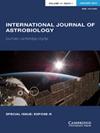Interaction between adenine and Cu2+ and Fe3+-montmorillonites: a prebiotic chemistry experiment
IF 1
4区 物理与天体物理
Q3 ASTRONOMY & ASTROPHYSICS
引用次数: 1
Abstract
The modification of minerals with metals can promote changes in their surface and, consequently, in their physicochemical properties. Minerals could have played an important role in the origin of life as they can protect molecules against degradation by radiation and hydrolysis, pre-concentrate molecules from dilute solutions and catalyse the formation of polymers. Thus, the current work studied the modification of montmorillonite with Cu2+ and Fe3+ ions. These modified montmorillonites were used to study the interaction with adenine dissolved in distilled water and artificial seawater 4.0 Gy (Gy = billion years ago). The most important result of this work is that the adsorption of adenine onto modified montmorillonites is a complex interaction among adenine, salts in seawater and Cu2+/Fe3+-montmorillonite (Cu2+/Fe3+-Mont) . The adsorption of Cu2+ and Fe3+ onto montmorillonite decreased its surface area and pore volume. The Sips isotherm model showed the best fit of the data and n values indicate that the adenine adsorption process was homogeneous. The highest adenine adsorption was obtained in artificial seawater 4.0 Gy onto Fe3+-Mont at 60°C and the lowest in distilled water or artificial seawater 4.0 Gy onto montmorillonite [montmorillonite washed with distilled water (Mont-STD)] at 60°C. Adenine adsorption onto Mont-STD/montmorillonite modified with 500 ml of 0.1 mol l−1 of CuCl2 and Fe3+-Mont was an exothermic process and an endothermic process, respectively. For all adsorptions ΔG was negative. The adsorption of adenine onto Fe3+-Mont was ruled out by entropy and the other samples by enthalpy and entropy, being a major contribution for Gibbs free energy from enthalpy. The Fourier transform-infrared data indicate that the interaction of adenine with minerals may occur through the NH2 functional group.腺嘌呤与Cu2+和Fe3+-蒙脱石的相互作用:一个益生元化学实验
用金属修饰矿物可以促进其表面的变化,从而改变其物理化学性质。矿物质可能在生命起源中发挥了重要作用,因为它们可以保护分子免受辐射和水解的降解,从稀释溶液中预先浓缩分子,并催化聚合物的形成。因此,本文研究了Cu2+和Fe3+离子对蒙脱土的改性。利用这些改性蒙脱石研究了在蒸馏水和人工海水中溶解的腺嘌呤(Gy =十亿年前)的相互作用。本工作最重要的结果是,腺嘌呤在改性蒙脱土上的吸附是腺嘌呤、海水中的盐和Cu2+/Fe3+-蒙脱土(Cu2+/Fe3+-Mont)之间的复杂相互作用。Cu2+和Fe3+在蒙脱土上的吸附减小了蒙脱土的表面积和孔隙体积。Sips等温线模型拟合最佳,n值表明腺嘌呤吸附过程是均匀的。60℃时,4.0 Gy的人工海水对Fe3+-Mont的腺嘌呤吸附量最高,60℃时,蒸馏水或4.0 Gy的人工海水对蒙脱土[蒸馏水洗涤蒙脱土(Mont-STD)]的腺嘌呤吸附量最低。用500 ml 0.1 mol l−1 CuCl2和Fe3+-Mont改性Mont-STD/蒙脱土对腺嘌呤的吸附分别为放热过程和吸热过程。对于所有吸附,ΔG为负。腺嘌呤在Fe3+-Mont上的吸附被熵排除,其他样品被焓和熵排除,是来自焓的吉布斯自由能的主要贡献。傅里叶变换红外数据表明,腺嘌呤与矿物质的相互作用可能是通过NH2官能团发生的。
本文章由计算机程序翻译,如有差异,请以英文原文为准。
求助全文
约1分钟内获得全文
求助全文
来源期刊

International Journal of Astrobiology
地学天文-地球科学综合
CiteScore
3.70
自引率
11.80%
发文量
45
审稿时长
>12 weeks
期刊介绍:
International Journal of Astrobiology is the peer-reviewed forum for practitioners in this exciting interdisciplinary field. Coverage includes cosmic prebiotic chemistry, planetary evolution, the search for planetary systems and habitable zones, extremophile biology and experimental simulation of extraterrestrial environments, Mars as an abode of life, life detection in our solar system and beyond, the search for extraterrestrial intelligence, the history of the science of astrobiology, as well as societal and educational aspects of astrobiology. Occasionally an issue of the journal is devoted to the keynote plenary research papers from an international meeting. A notable feature of the journal is the global distribution of its authors.
 求助内容:
求助内容: 应助结果提醒方式:
应助结果提醒方式:


